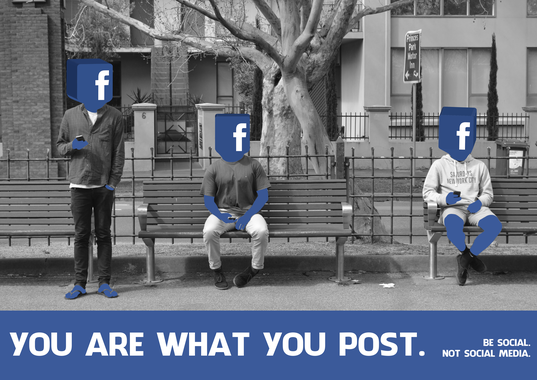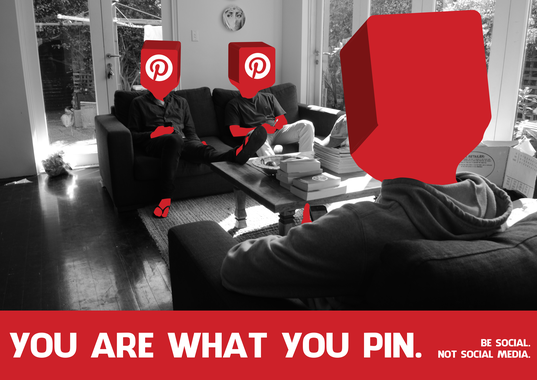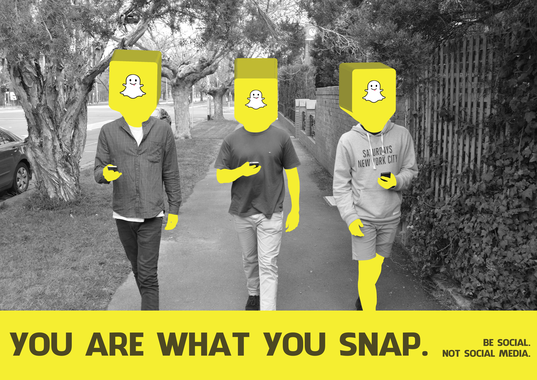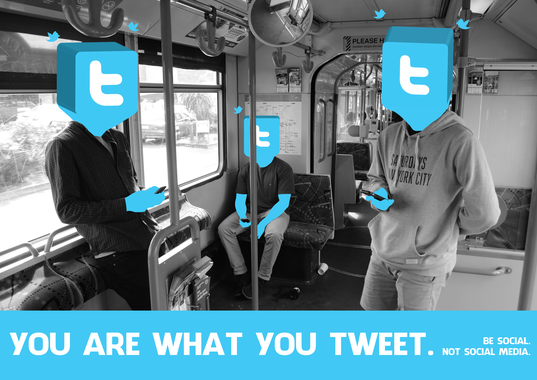Be Social. Not Social Media.
by KDUERDEN
This work has not been commented by curators.
Title
Be Social. Not Social Media.
Headline
We are our social media.
Concept author(s)
Kyle Duerden
Concept author year(s) of birth
1993
Concept author(s) contribution
Everything.
Concept author(s) Country
Australia
Designer(s)
Kyle Duerden
Designer(s) year(s) of birth
1993
Designer(s) contribution
Everything
Designer(s) Country
Australia
Friendly Competition
Radical intimacies: dialogue in our times (2014)
Competition category
Visual communication practice
Competition subcategory
static
Competition field
academic
Competition subfield
student
Subfield description
Swinburne University of Technology / Communication Design
Check out the Radical intimacies: dialogue in our times 2014 outlines of Memefest Friendly competition.
Description of idea
Describe your idea and concept of your work in relation to the festival outlines:
While doing my research for this brief, I always noticed how in day to day life no one would speak to each other. It was always heads down, locked into whatever smartphone we had, checking for updates on social media. But there never was, it was the same as 30 seconds ago when you last checked.
I came up with the concept of 'We are our social media.'
You are what you post / You are what you tweet / You are what you snap / You are what you pin.
The focus of the project was to shine a negative light on dialogue in an attempt to raise awareness of how engaged we are with social media. The digital dialogue. Catching trains and walking around the city I would see no interaction at all between strangers, they may lock eyes, but this was awkward and not to be done again.
The main idea of my project is to portray people as being their social media. Erase all human elements of them and make them a walking icon. Making them their social media.
What kind of communication approach do you use?
I knew I was always going to create something with the use of illustrator of photoshop. I just needed a direction. When I came across the works of Tyler Spangler it gave me an idea to create something which erased the faces of the social media user, and to replace it with the icon of the digital dialogue they were using. Once I got to this stage the process took control of itself and I just needed to take my photos and create the images. Digital dialogue was something I had never really thought of before, the language we didn’t speak. Through my research of dialogue and the readings and documentatries I became very aware of how much it influenes our community. I am looking at digital dialogue in a negative way for this brief because I believe that we are no longer speaking to the people around us, only the people we access within our hands. I hope my communication can bring awareness to more people in our community.
What are in your opinion concrete benefits to the society because of your communication?
From what I have noticed about our society today is that everyone seems to be locked into one or more social media platforms at a single time. We constantly check Facebook, even though we just checked it 2 minutes ago and nothing was going on.
It’s almost an instant reaction when you open your phone to log into an app to check what’s happening, when most of the time, nothing is. My communication has the design intention of creating a sense of guilt within the viewer. Making them realise that in fact, they are their social media.
You may walk down the street and see one of my posters and think to yourself ‘wow, thats me right now.’ This then sense of guilt along with the accompanying tag line ‘Be social. Not social media.’ Has the intention to make people understand how anti-social they are being with the real people or friends around them.
It will benefit the community because it is designed to spark awareness of how involved we are with our smartphones, that we are actually becoming the social media we are involved with. It is urging social media users to be more social with the people around them and engage in real dialogue.
What did you personally learn from creating your submitted work?
This brief made me truly realise how much time we all spend heads down locked into our phones. Catching the train to uni, sitting around home, hanging out with friends, I would always notice when someone was engaging in digital dialogue.
We would all be engaged in our own little world, with people who we may not even personally know, and we would rather that than to engage with our real friends and family around us. It opened up my eyes to see that it really is becoming a problem.
I also began to realise that because everyone is so okay with silence on a train, or not communicating with somebody you don’t know, that it is actually very hard to try and change this.
You would look at someone on the train and catch eyes, but you wouldn’t smile at each other, you would just continue with your own business and that would be your personal engagement for the day.
I would like to think that one day this can all change. I do like to sit and play on my phone here and there but to see everyone do it all day, every day makes me realise that there does need to be a change in our society.
Why is your work, GOOD communication WORK?
My work is deisgned with an intent, to create awareness and a sense of guilt.
Good Advertsining Design work to me needs a purpose and to convey its message quickly and effectively.
My series of posters instantly informs the viewer of the issue at hand. The vibrant colours of the social media and the greyscale imagery quickly conveys the message and with purpose. The text bar along the bottom of each piece is bold and informative,
‘You are what you post.’
I used the word ‘You’ over ‘We’ because it directly informs the viewer, making them feel that sense of insecurity and wonder to if that is infact them on that poster.
The campaign spans across different social media platforms so for someone who does not use Twitter they may not take notice, but if they use Facebook they will feel that sense of guilt I was hoping to achieve.
This guilt would then lead to the urge to overcome it and speak to someone in public. If they engage in this dialogue then my design has worked, and has worked well.
Where and how do you intent do implement your work?
My design pieces would be put up around the city and trainstops as A2 Landscape printouts.
Then they would also be placed on billboards around public transport stations because as the train would go past the passengers on board, eyes down on their phones would maybe see them and feel guilty and potentially engage in conversation with someone nearby.
I also would like to have them put on the ground around walkways and public transport. People walking by who are looking down at their phones would see the vibrant colours in the background and take notice.
The backs of train and bus seats as well would be a great spot for these posters as it would directly relate to those people on board.
Did your intervention had an effect on other Media. If yes, describe the effect? (Has other media reported on it- how? Were you able to change other media with your work- how?)
I had this idea from the start of the brief and my tutor told me to stick with it.








